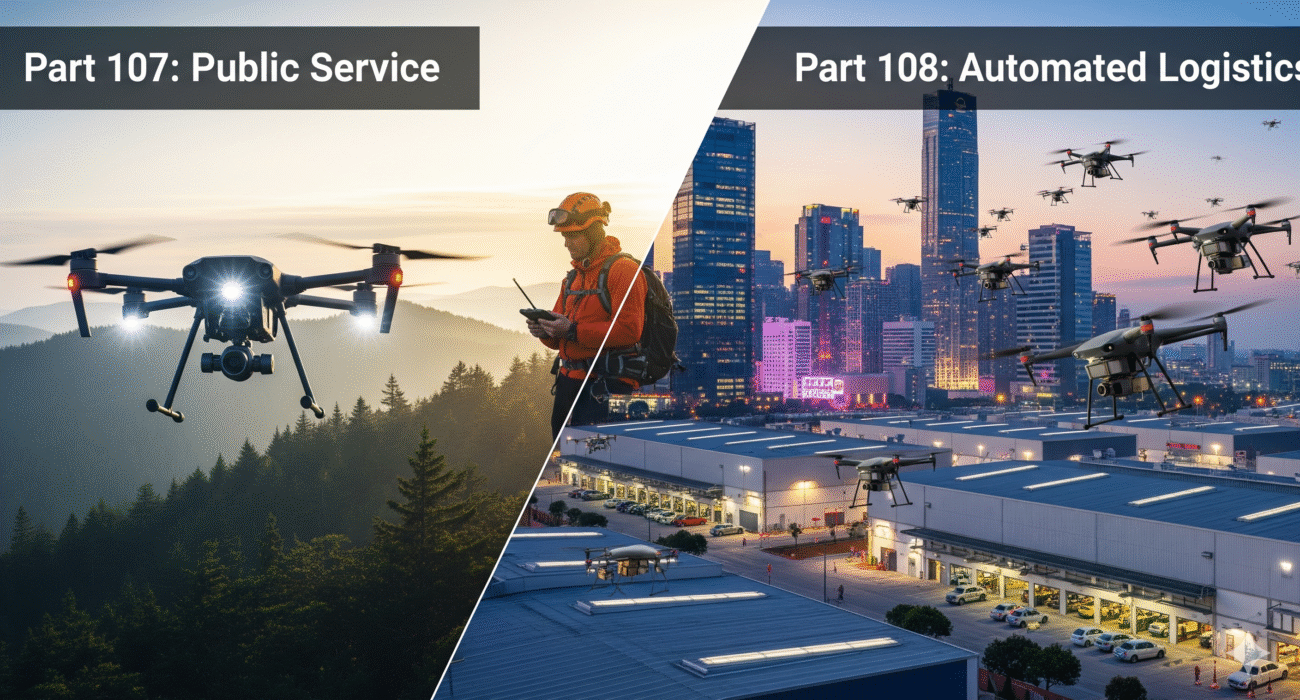Part 107 vs Part 108 Drone Certification: How, When, and Key Differences
Introduction
The drone industry in the U.S. has expanded rapidly across sectors—logistics, surveying, construction, defense, and public safety. With this growth, different certification standards are in place to ensure safe and regulated operations. Two important certifications often mentioned are FAA Part 107 and Part 108. While Part 107 is widely known for commercial drone pilots, Part 108 focuses on higher-level security, defense, and government operations.
This article explains the how, when, and differences between Part 107 and Part 108 certifications, helping aspiring drone professionals and organizations understand which path applies to them.
What is FAA Part 107?
- Scope: Governs small Unmanned Aircraft Systems (sUAS) under 55 lbs for commercial operations.
- Who needs it: Anyone flying drones commercially (real estate, mapping, inspection, media, agriculture, etc.).
- How to get it:
- Be at least 16 years old.
- Pass the FAA Aeronautical Knowledge Test (Part 107 exam).
- Obtain a Remote Pilot Certificate from the FAA.
- Typical jobs: Drone photographers, surveyors, inspectors, delivery pilots, ground observers.
What is FAA Part 108?
- Scope: Part 108 historically relates to aircraft operator security programs regulated by the TSA. In drone applications, it applies when UAS are integrated into security-sensitive, defense, or government operations.
- Who needs it: Operators engaged in flights that involve homeland security, military contracts, or critical infrastructure.
- How to get it:
- Work with a government or defense contractor requiring Part 108 compliance.
- Submit to TSA/FAA screening and security program approval.
- May require additional background checks, clearance, and operational audits.
- Typical jobs: Defense/UAV operators, federal contractors, airport drone operations, and high-security missions.
Key Differences Between Part 107 and Part 108
| Aspect | Part 107 | Part 108 |
|---|---|---|
| Purpose | Commercial drone operations under 55 lbs | Security-sensitive & defense-related drone operations |
| Who it applies to | Individuals, small businesses, commercial operators | Government, defense contractors, high-security operators |
| Certification process | Knowledge test + FAA Remote Pilot Certificate | Security program approval + TSA/FAA audits |
| Jobs covered | Real estate, mapping, inspections, media, agriculture | Military UAS, airport drone ops, homeland security, critical infrastructure |
| Accessibility | Open to any individual meeting FAA requirements | Restricted; requires sponsor or government affiliation |
When Should You Pursue Part 107 vs Part 108?
- Choose Part 107 if: You want to fly drones commercially for private companies, media, surveying, or delivery. This is the standard entry point for drone careers.
- Choose Part 108 if: You are working with the government, TSA, or a defense contractor, and your operations involve high-security or restricted airspace. You usually cannot self-apply—your employer or agency must initiate compliance.
Learning Path Recommendations
- Start with Part 107 – It opens the door to most drone jobs and is recognized across industries.
- Gain experience – Build hours in commercial projects like inspections, mapping, or logistics.
- Transition to Part 108 – If you move into defense or government projects, pursue Part 108 compliance through your employer.
Conclusion
Part 107 and Part 108 are not competing certifications—they serve different purposes. Part 107 is the foundation for most commercial drone pilots, while Part 108 applies in restricted, high-security contexts. Aspiring drone professionals should begin with Part 107 and be aware that opportunities in defense, homeland security, or critical infrastructure may eventually require Part 108 clearance.

